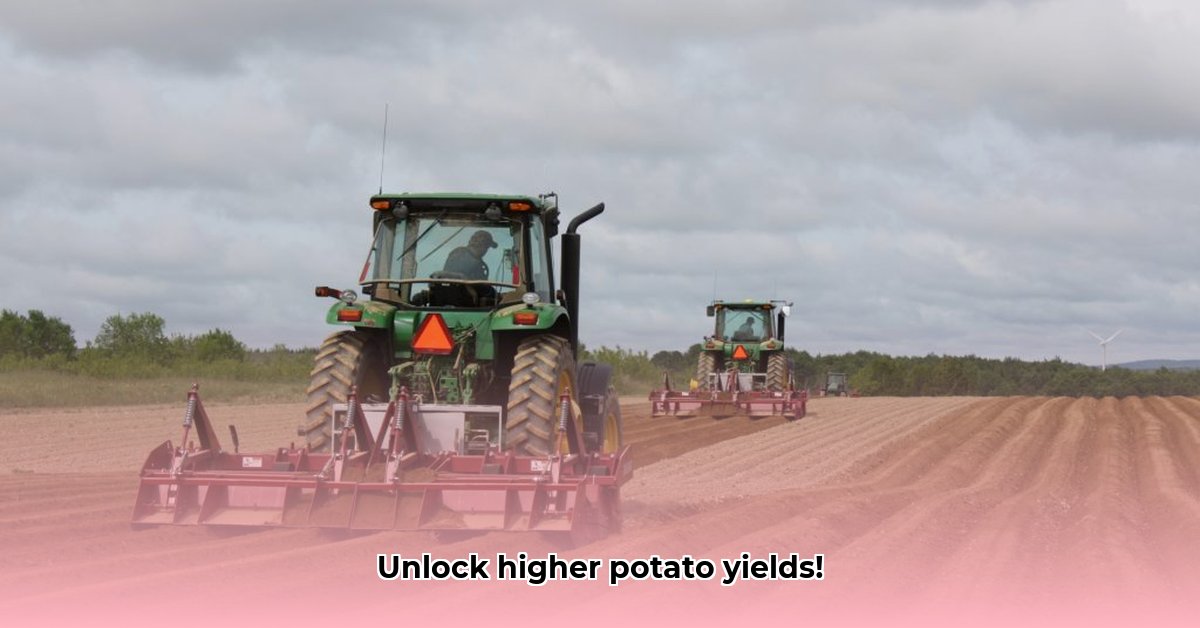
Potato Hiller for Tractor: Boosting Your Potato Harvest
Let's talk about potato hillers – those amazing tractor attachments that simplify potato farming and significantly boost yields. If you're cultivating potatoes on a larger scale, a potato hiller is an invaluable tool. It's not just about aesthetically pleasing rows; it's about maximizing your harvest. This comprehensive guide will empower you to understand, select, and utilize a potato hiller effectively. For other tractor attachments, check out this link to other tractor attachments.
What's a Potato Hiller and Why Do I Need One?
Imagine this: your potatoes are planted, and now they need protection from the sun, weeds, and even frost. That's where a potato hiller steps in. This tractor attachment builds mounds of soil over your potato rows. Why is this crucial? These hills act as a natural shield, providing shade (preventing greening and bitterness), retaining moisture, and suppressing weeds. It's like giving your potatoes a soil-based blanket. This leads to healthier potatoes, reduced weeding, and a larger yield. Wouldn't you agree that efficient weed control is key to a successful harvest?
Types of Tractor Potato Hillers: Finding the Right Fit
Several types of potato hillers exist, each with unique strengths and weaknesses. The optimal choice depends on your specific needs and conditions.
Disc Hillers: These robust machines use spinning discs to throw soil onto the rows. They effectively handle various soil types, but may require a more powerful tractor.
Rotary Hillers: Employing rotating rods or paddles instead of discs, these hillers are gentler on the soil, minimizing compaction. This is beneficial for healthy plant growth. They're ideal if you prioritize soil health.
Moldboard Hillers: These function like a plow, creating tall, defined ridges. If you prefer neat and precise hills, this is a good option. However, their effectiveness might vary depending on soil type.
Choosing the right hiller hinges on your specific conditions: soil type, operation size, and your tractor's capabilities. A more powerful tractor can handle disc hillers, while smaller tractors pair well with rotary or moldboard hillers.
Picking the Perfect Potato Hiller: Key Considerations
Selecting a potato hiller is akin to choosing the right tool for the job. Consider these factors:
Tractor Compatibility: Ensure compatibility with your tractor's horsepower and three-point hitch. Improper matching can damage equipment or significantly reduce performance.
Soil Type: Different soils present unique challenges. Sandy soil is loose, while clay can be resistant. Some hillers are better suited to particular soil types. Consult an equipment specialist for guidance.
Potato Variety and Row Spacing: The size and spacing of your potato rows will influence the hiller's design and settings. Select a hiller compatible with your row dimensions.
Budget: Potato hillers vary in price. Establish a realistic budget to avoid overspending or compromising quality.
Using Your Potato Hiller: A Step-by-Step Guide
Effective hiller use involves practice, but it's straightforward. Follow these steps:
Setup: Attach the hiller securely to your tractor, adjusting it for row spacing and desired hill height per the manual's instructions.
Speed Control: Maintain a steady, moderate speed. Excessive speed damages potatoes; slow speed is inefficient. Experiment to find the optimal speed for your conditions.
Depth Control: Proper depth is crucial. Too shallow offers inadequate protection; too deep risks damaging plants. Adjust the depth for effective coverage without harming the crop.
Overlapping Passes: Slightly overlap each pass for complete coverage. This ensures all potatoes are hilled effectively.
Regular Checks: Regularly monitor the hiller's operation and address any issues immediately. Prioritize safety by wearing appropriate gear.
Keeping Your Hiller in Top Shape: Maintenance Tips
Proper maintenance extends the hiller's lifespan and performance.
Cleaning: After each use, remove soil and debris to prevent clogs and corrosion.
Lubrication: Regularly lubricate moving parts according to the manufacturer's recommendations.
Sharpness: Maintain sharp blades or edges for efficient hilling.
Component Checks: Periodically inspect for wear and tear, replacing damaged components promptly.
Troubleshooting Common Problems
| Problem | Possible Cause | Solution |
|---|---|---|
| Uneven hilling | Incorrect adjustment, dull blades, clogged discs | Adjust settings, sharpen/replace blades, clear clogs |
| Erratic hiller movement | Worn bearings, loose bolts, hydraulic issues | Replace bearings, tighten bolts, check hydraulic lines |
| Excessive vibration | Imbalance, worn parts | Balance the hiller, replace worn parts |
| Hiller not engaging properly | Faulty three-point hitch connections, improper lever operation | Check three-point hitch, review operation instructions |
Preventative maintenance and regular inspections significantly reduce the likelihood of problems.
Key Takeaways
- A potato hiller greatly simplifies potato farming and improves yields.
- Choosing the right hiller depends on tractor compatibility, soil type, and budget.
- Proper maintenance and troubleshooting are key to efficient hiller operation.
By following these guidelines, you'll experience increased potato yields and a smoother harvesting season. Happy farming!